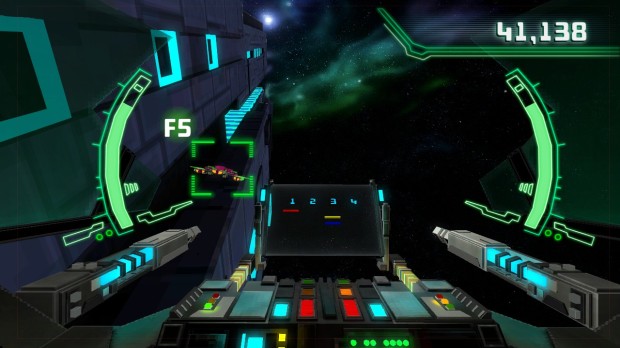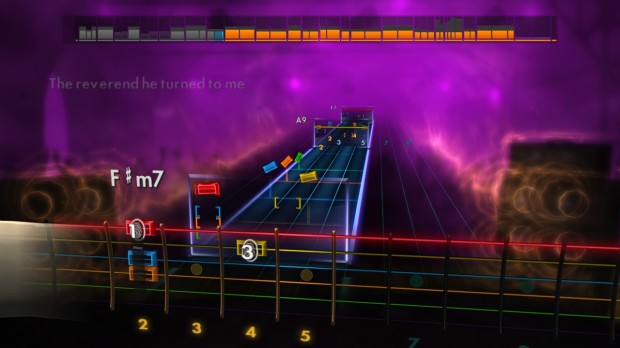Rocksmith 2014 Edition Forges Guitarists From Novice To Extremist (Review)
This game was reviewed on the Xbox 360 console.
In 2012, Ubisoft took the music and rhythm game genre in a new direction with Rocksmith, a game designed to teach you guitar using an actual instrument. Nearly two years later, they are looking to further improve the teaching medium with Rocksmith 2014. Sporting enhanced mechanics, new features, and a wider array of songs, this new title takes learning guitar to a whole new level – and makes it a lot easier to boot!
Now, why make a new game, and what’s the difference between the original and Rocksmith 2014? While the original Rocksmith was a decent teaching method and an overall entertaining game, it contained a lot of flaws, redundancies, and was frankly a bit of a hassle when it came to learning specific lines or songs. Rocksmith 2014 maintains a lot of what made the original great, but takes everything a step further, while ironing out the game’s wrinkles at the same time. As with its predecessor, the player can use virtually any guitar with a quarter inch input jack, including acoustic and classical guitars with built-in pickups, via use of the Real-Tone Cable (RTC), which converts from a quarter inch input from your guitar to a USB input for your console. Three versions of the game are currently available: the complete package, which comes with a Rocksmith recommended guitar, RTC, and the game disc; a guitar owners’ version, which comes with RTC and disc; and a previous owners’ version, containing only the game disc. The prices of these vary, and can be quite expensive if you need more than just the disc.
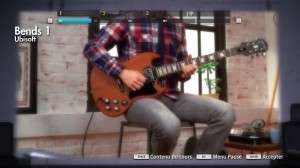 At your first boot-up, you’ll be asked a few basic questions. First, the game will ask if you’re familiar with Rocksmith‘s core mechanics, so new players will get the lowdown on basic principles, while returning players will get to the actual gameplay more quickly. Next you’ll be asked if you’re left- or right-handed, what shape your guitar’s headstock is (three tuning pegs on each side or six in a straight line), as well as what role you’d like to play: Lead, Rhythm, or Bass. Depending on your choices, the look of the game will change, along with the actual guitar part you will be playing. Lead tends to play the single note melodic lines, sometimes playing supporting chords; Rhythm plays mostly backing chords, with occasional supporting counter-melodies; and Bass is pretty self-explanatory: you play the low-end notes in the songs. Don’t worry about your initial choice though, as you can actively switch between these roles at any time while not in a song. After a quick guitar calibration or tuning (where you strum all the strings of your guitar to make noise to test the instrument’s volume), you’ll be brought to the Main Menu.
At your first boot-up, you’ll be asked a few basic questions. First, the game will ask if you’re familiar with Rocksmith‘s core mechanics, so new players will get the lowdown on basic principles, while returning players will get to the actual gameplay more quickly. Next you’ll be asked if you’re left- or right-handed, what shape your guitar’s headstock is (three tuning pegs on each side or six in a straight line), as well as what role you’d like to play: Lead, Rhythm, or Bass. Depending on your choices, the look of the game will change, along with the actual guitar part you will be playing. Lead tends to play the single note melodic lines, sometimes playing supporting chords; Rhythm plays mostly backing chords, with occasional supporting counter-melodies; and Bass is pretty self-explanatory: you play the low-end notes in the songs. Don’t worry about your initial choice though, as you can actively switch between these roles at any time while not in a song. After a quick guitar calibration or tuning (where you strum all the strings of your guitar to make noise to test the instrument’s volume), you’ll be brought to the Main Menu.
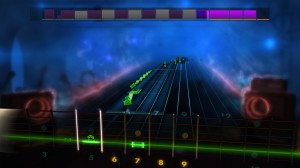 As mentioned above, the core layout of Rocksmith returns to 2014, just with a few more augments. Players are presented a virtual fret board and strings, in which a series of colour-coded notes will approach the player, moving forward from off-screen. As with any rhythm game, such as DDR or Guitar Hero, the idea is to hit the displayed note at the time it contacts the displayed string. The obvious difference with 2014 is that you need to play the actual fret and the actual string on the actual guitar. As you start out, the lines will be devilishly simple, consisting of just one or two notes within the actual phrase. As you start to play these correctly, and gain more experience with the instrument, you will have more and more notes being added, until you’re playing the songs exactly as the artist does! To help know just when to hit each note, the layout is subdivided to show the inner beats of the song, just like in sheet music. A small section of the fret board is often highlighted as well, letting you know what position to keep your fingers in to best play the current selection of notes. What’s really great about this layout though, is that it’s really tailored to each and every skill level. If you’re brand new to playing the guitar, it will notice, and keep everything toned down until you start to play more accurately. This also works the other way around, as skilled players will see their lines advancing in difficulty at a faster pace, and new songs will even start out harder on your first attempt.
As mentioned above, the core layout of Rocksmith returns to 2014, just with a few more augments. Players are presented a virtual fret board and strings, in which a series of colour-coded notes will approach the player, moving forward from off-screen. As with any rhythm game, such as DDR or Guitar Hero, the idea is to hit the displayed note at the time it contacts the displayed string. The obvious difference with 2014 is that you need to play the actual fret and the actual string on the actual guitar. As you start out, the lines will be devilishly simple, consisting of just one or two notes within the actual phrase. As you start to play these correctly, and gain more experience with the instrument, you will have more and more notes being added, until you’re playing the songs exactly as the artist does! To help know just when to hit each note, the layout is subdivided to show the inner beats of the song, just like in sheet music. A small section of the fret board is often highlighted as well, letting you know what position to keep your fingers in to best play the current selection of notes. What’s really great about this layout though, is that it’s really tailored to each and every skill level. If you’re brand new to playing the guitar, it will notice, and keep everything toned down until you start to play more accurately. This also works the other way around, as skilled players will see their lines advancing in difficulty at a faster pace, and new songs will even start out harder on your first attempt.
On the Main Menu, you have a plethora of choices, the most common of which will be Learn a Song. In this mode, players pick a song, and play it – simple as that. 2014 has a large list of songs to choose from, including the distorted riffs in Jack White’s “Sixteen Saltines”, the laid back acoustic of REM’s “Losing My Religion”, and the deep growls of The Deftones’ “My Own Summer (Shove It)”. A new feature in terms of soundtrack is the inclusion of alternative tuning songs, such as Eb standard, drop Db, and even slightly off-key tunings. This type of change opens the door for more downloadable content (DLC) in the future. Furthermore, any DLC you purchased from the original can be used in 2014, and has been enhanced, or in some cases even extended for better replay value. Also, a Rocksmith import pack is available for purchase, which will bring the majority of the original on-disc songs into the new game – all remastered and upgraded. The complete song selection is actually widely varied, and you can find the complete track list here.
Simply playing the song from front to back isn’t very productive though – what if you struggle in just one area? That’s where Riff Repeater comes in (a returning feature from Rocksmith). At the push of a single button, you can take any section apart, slow it down, learn it bit by bit, and then continue along with the song, or start it over again instantly. Many options within this mechanic can be changed, such as error tolerance (whether you need to play every note exactly to level up the phrase, most of them, or less), repetitions of a slower speed, and you can even tie in multiple phrases together. This is helpful in ensuring you can combine separate sections properly, without it sounding terrible. The mechanic was actually separate from the main play mode in the original game, and featured considerably less options. Players would constantly have to load and re-load both the various features of Riff Repeater, as well as the actual song, which was a terrible pain. By expanding this mode as much as they have and enabling the player instant access to it, the developer has given the gamer an invaluable, instant tool that will make their playing all the better.
Want a bit of a challenge? Try out Score Attack! This mode breaks down the song as a while into one of four different difficulties (Easy, Medium, Hard, and Master) in a fashion similar to the Guitar Hero games, and challenges you to play through them without making too many mistakes in a phrase. Mess up too many times, the phrase will fail and you’ll get a strike – three and you lose! The harder the difficulty, the less you can mess up before failing. Depending on how well you do, you will be given a score, which is posted on the global Leaderboards, effectively earning you some bragging rights.
As a fun way to teach you some basic guitar knowledge, the Guitarcade returns from the previous title. Here, you can play one of many fairly entertaining mini-games, each centered around a single technique. One such example is Temple of Bends, where you must bend a note on a specific fret to an exact degree to allow a small adventurer to climb some vines to escape a slowly descending spiked ceiling. The idea behind this is to help develop your fingers’ fine muscle skills to better hit different bend intervals, while keeping the lessons from feeling just like that – a lesson. Other skills teachable via this mode are string skipping, sliding, scales, and chords – to name a key few. Just like with score attack, your final score is tallied and posted on the global Leaderboards, giving you some extra incentive to put in the time practicing your base techniques.
Should you desire an actual lesson though, 2014 has several interactive tutorials designed at teaching you all the ins-and-outs of your instrument, from the bare basics like tuning and hammer ones/pull offs, to advanced lessons like two-handed tapping. Different lesson difficulties exist within various lessons, often teaching you the base idea first before working your way into advanced instances of them. These lessons come packed with video examples of the skill you’re trying to learn, so you can see the technique in action. While these lessons don’t teach the player all the skills and tricks under the sun, they do go into great detail about a lot of them, and will be key to the development of a gamer’s guitar skills.
 Also returning from Rocksmith is the tone editor, though this time it comes with a nice set of enhancements. Players can decide every aspect of their guitar’s sound by choosing between several amps and pedals, all of which can be customised to fit your specific needs. Aside from customizable tones, you can even load up any of the authentic sounds from different sections of the game’s songs, if a certain tone has taken your fancy. Up to four different sounds can be mapped to shortcuts, so you can change to your favourites on the fly. The best part of the new tone editor, is that it allows players to automatically change tones mid-song, a feature strangely missing from the original. This allows the player to play the intro to a song using distortion, such as switching to a ‘wa-wa’ sound for the chorus, and using a clean tone for the bridge. Every song has its own default layout, and your tone will switch automatically as the sections require it, although you’re free to change to your pre-sets at will.
Also returning from Rocksmith is the tone editor, though this time it comes with a nice set of enhancements. Players can decide every aspect of their guitar’s sound by choosing between several amps and pedals, all of which can be customised to fit your specific needs. Aside from customizable tones, you can even load up any of the authentic sounds from different sections of the game’s songs, if a certain tone has taken your fancy. Up to four different sounds can be mapped to shortcuts, so you can change to your favourites on the fly. The best part of the new tone editor, is that it allows players to automatically change tones mid-song, a feature strangely missing from the original. This allows the player to play the intro to a song using distortion, such as switching to a ‘wa-wa’ sound for the chorus, and using a clean tone for the bridge. Every song has its own default layout, and your tone will switch automatically as the sections require it, although you’re free to change to your pre-sets at will.
A very interesting new addition to 2014 is Session Mode, which gives you a virtual band to play along with. Players are able to either select a pre-set band, or design their own, and jam out along with different AI musicians. Your band can consist of up to four musicians, who can include Drummers, Percussionists, Bassists, Guitarists, and Keyboardists, each able to play a wide array of different instruments and styles. As well, you may also adjust their individual volumes, and left-right balance. Once they are in order, you can then select your key/scale type, tempo, chord progression, style, and many other settings. Once your band is customized and ready, you can launch your session and start playing. You will be presented with a nice little scale diagram, with specific notes highlighted. These are the base notes within the current chord, and playing them is guaranteed to sound good with the overall harmony. As you openly play to your heart’s content, the band will up its intensity to match you; as you keep a mellow, tasteful melody, the band will keep things quiet, and their insertions sparse. Get into some crazy shredding though, and the band will get more intense, potentially even upping the tempo on you. While a far cry from sitting down with your friends and writing music, this feature will give aspiring writers a place to sit down and test out riff or solo ideas, in the safety and convenience of their own home.
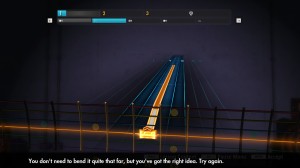 2014 also comes packed with a nice array of customization options, including fret inlays and cabinet colours. Your fret inlays (the nice little objects on the fret board used to show specific fret numbers) can be changed to various shapes, from the traditional single dots, to stylish tribal designs. These are places on the virtual fret board, as serve as an extra reminder as to what hand position you are in. As for your amps and cabinets, while you may be particular to a certain brand and sound, you can change the device’s outer shell colour. While these are small things, they really help the gamer feel at home in the game, and give the layout a nice visual flair.
2014 also comes packed with a nice array of customization options, including fret inlays and cabinet colours. Your fret inlays (the nice little objects on the fret board used to show specific fret numbers) can be changed to various shapes, from the traditional single dots, to stylish tribal designs. These are places on the virtual fret board, as serve as an extra reminder as to what hand position you are in. As for your amps and cabinets, while you may be particular to a certain brand and sound, you can change the device’s outer shell colour. While these are small things, they really help the gamer feel at home in the game, and give the layout a nice visual flair.
What really sets 2014 apart though is its suggestions feature. At any given time, from the moment you start the game, you are given three different suggestions. At first they may be as simple as “play a new song” or “design a custom tone,” but will eventually get into things like “reach 90% completion of a song” or “complete a 150-note streak.” These tasks give the play a sense of direction, and act like a set of lesson plans, which keep you moving forward on your path to guitar-godhood.
One huge problem that rears its ugly head in the game is audio lag. As with the original game, 2014 will suffer from a very noticeable, and in some cases unplayable lag when running directly though the TV via HDMI. You will hit a note, and nearly a second later hear the sound. This makes playing along with a song very difficult, as even if you are dead on for note accuracy, your sounds will always be behind the supporting track. Component and composite cable setups will have less lag, and are pretty playable, but it will still be slightly noticeable and will drive a good chunk of gamers crazy. However, should you run a gaming headset or surround sound system the lag is non-existent – as long as your systems are running directly out of the console and not out of the TV. While gamers who already have these peripherals will be unaffected, it will add an additional cost to an already pricey game, which will dissuade a lot of people from picking it up.
So, the final question: is Rocksmith 2014 a viable teaching method? The quick answer: yes. With a selection of over 50 songs, interactive lessons, and several additional teaching mechanics, this is a great way to start learning guitar. While the initial cost may seem steep at first, compare it to the monthly costs of private lessons and you’ll see it’s certainly worth the price. While it’s highly recommend that an aspiring guitarist take additional, real-world lessons, this is a great place for first time players to sharpen their teeth, or for experienced shredders to learn new material and have some fun.
About This Post
